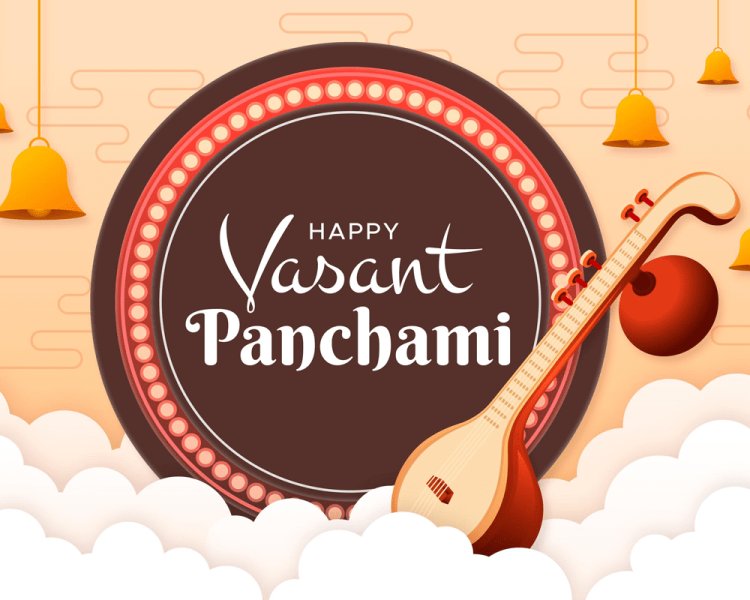A Symphony of Spring: Unveiling the Essence of Vasant Panchami (February 14th)
On the canvas of the Indian calendar, amidst the vibrant strokes of festivals, Vasant Panchami stands out as a lyrical ode to renewal. Celebrated on the fifth day of the bright fortnight of the Magha month, it marks the gentle transition from winter's slumber to spring's verdant embrace. It's a day cloaked in the hues of saffron yellow, echoing the warmth of the sun's kiss upon the awakening earth. But Vasant Panchami is more than just a seasonal shift; it's a symphony of cultural melodies, where ancient traditions blend seamlessly with the joy of new beginnings.

Celebrating Spring's Arrival:
The very name, "Vasant Panchami," whispers the fragrance of spring. "Vasant" translates to "spring," while "Panchami" signifies the fifth day, marking its position on the lunar calendar. It's a time when nature sheds its winter garb and dons a dazzling attire of blooming flowers, chirping birds, and gentle breezes. Trees come alive with emerald leaves, and fields transform into carpets of yellow mustard flowers, mirroring the vibrant attire worn on this auspicious day.
Homage to the Goddess of Knowledge:
However, Vasant Panchami's essence goes beyond just the earthly realm. It's a day dedicated to Goddess Saraswati, the embodiment of knowledge, wisdom, music, and the arts. Temples resonate with devotional hymns as devotees, clad in yellow, offer prayers and seek blessings for learning and creative pursuits. Educational institutions witness special pujas and cultural programs, creating an atmosphere of reverence and inspiration.
The Rituals of Vasant Panchami:
The rituals of Vasant Panchami are as diverse as the regions that celebrate it. Homes are adorned with mango leaves and marigold flowers, symbolizing prosperity and auspiciousness. In Punjab, kites painted with vibrant colors dot the sky, signifying freedom and soaring aspirations. In Bengal, Saraswati Puja takes center stage, with intricate mandalas crafted from colorful powders and offerings made to the goddess. Students seek blessings upon their books and instruments, hoping to imbibe the goddess's wisdom and grace.
A Cultural Tapestry:
Vasant Panchami transcends religious boundaries, weaving a tapestry of shared customs and traditions. In Maharashtra, the festival is known as Basant Panchami, marked by kite flying and the consumption of "shrikhand," a sweet dish symbolizing the bounty of spring. In South India, it's celebrated as Saraswati Pooja or Vasantha Panchami, with offerings of yellow turmeric and jasmine flowers to the goddess.
The Blossoming Origins of Vasant Panchami: A Journey Through Time
Vasant Panchami's origins, like the delicate tendrils of spring vines, weave through the tapestry of ancient Indian history and mythology. While pinpointing an exact date is challenging, its roots likely lie in the Vedic period, deeply intertwined with the worship of nature and celestial bodies.
Early Glimpses of Spring's Celebration:
- Vedic roots: The Vedas, the oldest scriptures of Hinduism, mention rituals associated with the arrival of spring and the worship of Surya, the sun god, whose increasing dominance over days symbolizes the lengthening daylight hours characteristic of the season.
- Harvest connection: Early celebrations likely coincided with the spring harvest, a time of thanksgiving and renewed prosperity. Offerings to deities associated with fertility and agriculture might have marked this occasion.
Evolution of the Festival:
- Goddess Saraswati's emergence: Over time, the festival became increasingly associated with Goddess Saraswati, whose iconography aligns perfectly with spring's vibrancy and knowledge's blossoming. Her association with music, arts, and learning resonated with the pursuit of wisdom often undertaken during this season.
- Literary and cultural influences: Classical texts like the Rig Veda and later works like Kalidasa's "Ritusamhara" offer glimpses of spring celebrations, highlighting the association with yellow attire, kite flying, and offerings to deities.
- Regional variations: As regional cultures flourished, Vasant Panchami adopted diverse names and customs. In Bengal, Saraswati Puja became central, while kite flying gained prominence in Punjab and Maharashtra.
Modern-Day Significance:
While the core essence of Vasant Panchami remains rooted in its ancient past, its contemporary celebration reflects changing times. Educational institutions now play a significant role, organizing cultural programs and encouraging academic pursuits. Environmental awareness has led to eco-friendly practices like using paper kites instead of plastic ones.
A Timeless Legacy:
From its Vedic roots to its modern-day expressions, Vasant Panchami's journey reflects the dynamism of Indian culture. It serves as a timeless reminder to welcome new beginnings, embrace knowledge, and appreciate the beauty of nature's cycles. As we celebrate this vibrant festival, we connect with our rich heritage and carry forward its message of hope and renewal for generations to come.
Historical Figures and Literary Gems Honoring Vasant Panchami
Vasant Panchami's journey through history has interwoven itself with renowned figures and captivating literary works, adding depth and meaning to its cultural tapestry. Here are some noteworthy examples:
Historical Figures:
- Raja Ram Mohan Roy: This social reformer and educationist is credited with reviving Saraswati Puja in Bengal during the 19th century. His efforts played a crucial role in popularizing the festival and associating it with educational institutions.
- Swami Vivekananda: Known for his powerful speeches and revivalist approach, Vivekananda often used the symbolism of Vasant Panchami to emphasize the importance of education and the awakening of knowledge within individuals.
- Rabindranath Tagore: This Nobel laureate poet composed numerous songs and poems dedicated to Saraswati and Vasant Panchami. His work, "Basanter Gane" (Songs of Spring), beautifully captures the essence of the season and its connection to creativity.
Literary Works:
- Rig Veda: This ancient collection of hymns mentions rituals associated with spring and the sun god, Surya, reflecting early forms of Vasant Panchami celebrations.
- Ritusamhara by Kalidasa: This classical poem vividly describes the beauty of spring, mentioning yellow attire worn during the season and offerings made to deities.
- Meghadūta by Kālidāsa: This cloud messenger poem contains verses that evoke the imagery of Vasant Panchami, describing blooming flowers and the chirping of birds.
- Kumara Sambhava by Kālidāsa: This epic poem features a verse comparing Parvati, the goddess of power, to the arrival of spring, highlighting the association of the season with renewal and divine grace.
- Chhayavad period literature: This era in Bengali literature, spanning the early 20th century, saw numerous poems and prose works dedicated to Vasant Panchami and Saraswati, with authors like Jibanananda Das and Sukumar Ray celebrating the beauty and symbolism of the festival.
Vasant Panchami's Many Faces: A Bouquet of Regional Variations
While widely known as Vasant Panchami, this joyous festival unfolds across India like a vibrant tapestry woven with diverse threads. Each region celebrates its unique flavor, adding richness to the overall experience. Here's a glimpse into some variations:
North India:
- Basant Panchami (Punjab, Haryana, Delhi): Kite flying takes center stage, symbolizing soaring aspirations and freedom. Yellow dominates clothes and sweets, signifying the sun's warmth and prosperity.
- Saraswati Puja (North India): Educational institutions hold pujas honoring Goddess Saraswati, seeking blessings for academic pursuits. Students touch books and instruments for divine knowledge.
East India:
- Saraswati Puja (Bengal, Odisha): Elaborate pujas are held at homes and temples, featuring exquisitely crafted mandalas and offerings of yellow flowers and turmeric. Musicians and artists seek blessings for their creative endeavors.
- Boishakhi (Assam, Bangladesh): This regional New Year coincides with Vasant Panchami, marked by traditional Bihu dances, feasting, and wearing new clothes.
South India:
- Vasantha Panchami (Tamil Nadu, Karnataka, Kerala): The focus shifts to Goddess Saraswati, with pujas and offerings of yellow cloth and jasmine flowers. Yellow 'kanjivaram' sarees are worn by women in Tamil Nadu.
- Huli (Karnataka): This unique celebration involves throwing colored water and powder, marking the victory of good over evil and welcoming spring's bounty.
Western India:
- Basant Panchami (Maharashtra): Kite flying dominates alongside a sweet dish called 'shrikhand,' symbolizing abundance and fertility. People wear yellow and adorn homes with mango leaves.
- Holi (Across India): Though celebrated later, Holi shares thematic links with Vasant Panchami, marking the triumph of good and welcoming spring's colors.
Beyond these major variations, countless regional nuances exist. In Gujarat, a kite festival coincides with Vasant Panchami. In Madhya Pradesh, students visit Saraswati temples carrying books for blessings. Every region adds its unique brushstroke to the vibrant canvas of this spring celebration.
Vasant Panchami's Symphony: A Journey Through Literature, Poetry, and Music
Vasant Panchami, with its vibrant hues and joyous spirit, has long inspired artists across various mediums. From the evocative verses of classical poetry to the rhythmic melodies of folk songs, the festival finds expression in a symphony of creativity. Let's explore how Indian literature, poetry, and music capture the essence of this unique celebration:
Literature:
- Ancient Roots: The Rig Veda, the oldest Hindu scripture, mentions rituals marking the arrival of spring, laying the foundation for literary depictions of Vasant Panchami.
- Classical Flourishes: In Kalidasa's "Ritusamhara," spring comes alive with vibrant descriptions of blooming flowers, yellow attire worn during the season, and offerings made to deities. Similarly, "Meghadūta" by Kālidāsa paints a picture of spring with verses evoking birdsong and blooming landscapes.
- Regional Expressions: Regional literature celebrates Vasant Panchami in various forms. Rabindranath Tagore's "Basanter Gane" beautifully captures the essence of Bengali spring, while Chhayavad period Bengali literature features works by Jibanananda Das and Sukumar Ray dedicated to the festival.
- Modern Voices: Contemporary authors continue to draw inspiration from Vasant Panchami. Ruskin Bond's "A Flight of Kites" paints a heartwarming picture of the festival in the hills, while Chitra Divakaruni's "Arranged Marriage" captures the significance of Saraswati Puja in the lives of young women.
Poetry:
- Odes to Spring: From ancient Sanskrit verses to modern compositions, Vasant Panchami has inspired countless poems celebrating the beauty of spring. Sanskrit poets like Bhartṛhari and Jayadeva composed verses praising the season's rejuvenation and its association with love and renewal.
- Saraswati's Hymns: Devotional poems dedicated to Goddess Saraswati form a significant part of the literary landscape. Bhakti poets like Sant Kabir and Mirabai composed heartfelt verses seeking her blessings for knowledge and creativity.
- Regional Folk Traditions: Every region boasts its own vibrant folk poetry tradition celebrating Vasant Panchami. Bengali 'Baul' songs extol the beauty of spring and divine love, while Punjabi 'Heer Ranjha' ballads often use spring imagery to depict their tragic love story.
Music:
- Classical Raga: Indian classical music offers a unique lens through which to experience Vasant Panchami. Ragas like Basant Bahar and Basant Mukhari capture the essence of spring with their delicate melodies and joyous rhythms.
- Folk Melodies: Regional folk music plays a vital role in Vasant Panchami celebrations. In Bengal, traditional 'Alpana' songs resonate with the spirit of Saraswati Puja. In Punjab, energetic 'Bhangra' beats accompany kite flying.
- Devotional Hymns: Throughout India, devotional hymns dedicated to Goddess Saraswati fill the air during Vasant Panchami. These hymns, sung in various languages and styles, invoke her blessings for knowledge, music, and the arts.
Vasant Panchami's artistic expressions go beyond individual mediums. Poetry often finds its way into music, and literary works inspire visual representations. This interconnectedness creates a rich tapestry of experiences, allowing people to connect with the festival's essence through different forms of art.
Verses, Poems, and Songs: A Glimpse into Vasant Panchami's Artistic Legacy
1. A Sanskrit Verse from "Ritusamhara" by Kalidasa:
"The mango trees, adorned with new foliage, seem to wear yellow shawls, As if to welcome the spring, the king of all seasons."
2. A Devotional Hymn from Bengal dedicated to Saraswati:
"Ya devi sarvabhuteshu, shuddha swarupa shankshita, Swarada roopa shobhita, tvatte namas tasmai namah."
(Translation: "Oh Goddess, residing in all beings, embodiment of pure knowledge, Adorned with the form of sound, I bow to you, I bow to you.")
3. An Excerpt from Rabindranath Tagore's "Basanter Gane" (Songs of Spring):
"Basante phule phutechhe shundar, Aji mone phire Ananda dhara (The flowers bloom beautifully in spring, Today my heart overflows with joy)"
4. A Popular Punjabi Folk Song during Kite Flying:
"Udd ja, patang udd ja, le ja meri duaa, Uchhe uchhe udd ja, chhoo le gagan nu chha."
(Translation: "Fly high, kite, fly high, carry my wish, Soar high, touch the sky's touch.")
5. A Modern Poem by Chitra Divakaruni from "Arranged Marriage":
"Today is Basant Panchami, the festival of learning. They offer Saraswati yellow marigolds and sweets, Hoping for wisdom, for wit, for the tongue to bloom..."
These are just a few examples, and there are countless other beautiful pieces of art dedicated to Vasant Panchami and Saraswati. Exploring music, poetry, and literature from different regions of India can open doors to a deeper understanding and appreciation of this vibrant festival.
Vasant Panchami: A Symphony of Hope, Renewal, and Learning
Beyond its vibrant colors, delicious sweets, and joyful celebrations, Vasant Panchami carries a universal message that transcends cultures and resonates with hearts across the globe. It's a potent reminder of the cyclical nature of life, where winter's slumber gives way to spring's vibrant awakening, urging us to embrace hope, renewal, and the pursuit of knowledge.
Hope's Blossoming:
Vasant Panchami arrives like a beacon of light amidst the colder months, symbolizing the triumph of hope over despair. The burgeoning blooms and lengthening days whisper promises of new beginnings, reminding us that even in the darkest times, light and warmth eventually return. Just as nature sheds its winter coat and bursts forth with life, this festival encourages us to do the same – to shed any negativity holding us back and embrace the potential for growth and joy.
Renewal's Embrace:
The essence of Vasant Panchami lies in the concept of "nava-vasant," or "new spring." It's a call to shed our old skin, both literally and figuratively. We are encouraged to declutter our minds and spaces, letting go of outdated ideas and habits that no longer serve us. This renewal extends beyond the personal sphere, encouraging us to contribute to a better world by planting trees, fostering community spirit, and embracing sustainable practices.
Learning's Eternal Flame:
At the heart of Vasant Panchami lies the veneration of Goddess Saraswati, the embodiment of knowledge, wisdom, and creativity. Her presence reminds us that learning is not confined to classrooms or textbooks; it's a lifelong journey of exploration, curiosity, and self-discovery. Vasant Panchami reignites the flame of learning within us, inspiring us to explore new avenues, hone our skills, and contribute meaningfully to society.
A Message for All:
This universal message of hope, renewal, and learning transcends cultural boundaries. Whether you celebrate Vasant Panchami with traditional rituals or simply connect with its underlying spirit, let its essence guide you. Embrace the new beginnings spring offers, shed negativity, cultivate knowledge, and contribute to a more vibrant and hopeful world. Remember, like the delicate spring blooms, each of us has the potential to blossom and contribute to the beauty of life.
So, as you celebrate Vasant Panchami, let its message resonate within you. Hope for a brighter future, embrace the possibility of renewal, and ignite the flame of lifelong learning. Together, let us create a world where spring's vibrancy blossoms not just in nature, but in our hearts and minds as well.
What's Your Reaction?


















